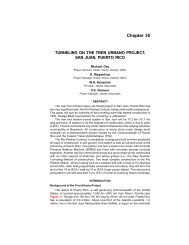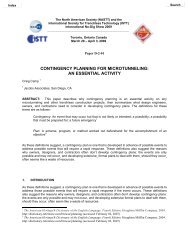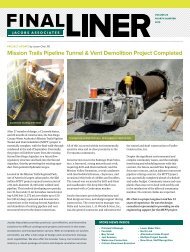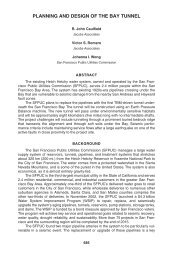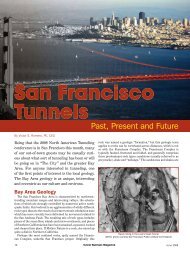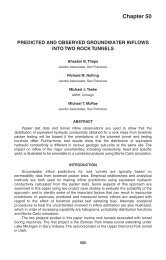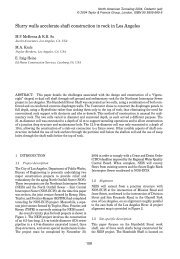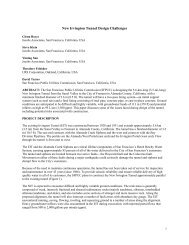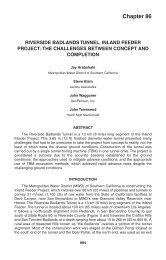Willamette River CSO Shafts - Jacobs Associates
Willamette River CSO Shafts - Jacobs Associates
Willamette River CSO Shafts - Jacobs Associates
You also want an ePaper? Increase the reach of your titles
YUMPU automatically turns print PDFs into web optimized ePapers that Google loves.
VOLUME 21<br />
SECOND QUARTER<br />
2010<br />
PROJECT UPDATE by Mark Havekost, PE<br />
<strong>Willamette</strong> <strong>River</strong> <strong>CSO</strong> <strong>Shafts</strong><br />
The City of Portland Bureau of Environmental<br />
Services is in the final years of constructing an<br />
underground infrastructure network to reduce<br />
combined sewer overflow (<strong>CSO</strong>) into the <strong>Willamette</strong><br />
<strong>River</strong>. To date, 15 major tunnel construction<br />
shafts and over 35 shafts for microtunneling<br />
have been built. In addition to construction<br />
management of the <strong>CSO</strong> tunnels, <strong>Jacobs</strong> <strong>Associates</strong>’<br />
involvement in the <strong>Willamette</strong> <strong>River</strong> <strong>CSO</strong><br />
Program has included evaluation and design of<br />
several critical tunnel and pipeline shafts. These<br />
shafts have been excavated through landfill<br />
debris, very soft silt, flowing sands, and open<br />
gravel, cobbles, and boulders. Such challenging<br />
ground conditions have required innovative construction<br />
methods, including hybrid modifications<br />
to traditional shaft construction methods.<br />
For the Portsmouth Force Main Segment 1<br />
Project, a three-sided, internally braced secant<br />
pile shoring system with a jet-grouted base seal<br />
is being constructed against the wall of the<br />
129-foot internal diameter (39 m), 165-footdeep<br />
(50 m) Swan Island Pump Station. This<br />
shaft will be used to break in to the pump<br />
station and install a bifurcated connection<br />
between the pump station and force main.<br />
The secant piles are constructed using a cased<br />
secant pile (CSP) method, which consists of an<br />
interior continuous flight auger and an outer<br />
temporary casing. The auger is advanced to<br />
design depth, then withdrawn as concrete is<br />
pumped through the auger tip. No soil is removed<br />
until auger and casing are withdrawn.<br />
Mark manages <strong>Jacobs</strong> <strong>Associates</strong>’ Portland<br />
office. He has participated in the design,<br />
construction, or evaluation of many of the<br />
tunnels and shafts that make up Portland’s<br />
<strong>Willamette</strong> <strong>River</strong> <strong>CSO</strong> Program. He is currently<br />
the project manager for contractor<br />
design on the Balch Consolidation Conduit.<br />
Several <strong>CSO</strong> program elements currently<br />
under construction connect existing infrastructure<br />
with the large West Side and East<br />
Side <strong>CSO</strong> storage tunnels. These connections<br />
require the creation of new openings in (i.e.,<br />
“breaking into”) existing tunnels and shafts.<br />
For the Portsmouth Force Main Segment 2<br />
Project, an egg-shaped liner plate shaft is being<br />
used to construct a connection to an existing<br />
tunnel, which is exposed and supported at the<br />
base of the shaft. The shaft shape was selected<br />
so the tunnel shield could be removed without<br />
altering or bypassing the existing structure.<br />
For the Balch Consolidation Conduit, <strong>Jacobs</strong><br />
<strong>Associates</strong> designed circular and rectangular<br />
microtunneling shafts for the cutter soil mixing<br />
(CSM) method. Rectangular panels were<br />
excavated by adding water, and sometimes<br />
bentonite, to the soil to fluidize it in place to<br />
a prescribed depth. Upon retraction, cement<br />
grout is mixed with the fluidized soil to form<br />
a soil cement mixture. Individual panels are<br />
interlocked to form watertight walls.<br />
At the bottom of the 112-foot (34 m)<br />
Portsmouth Force Main Segment 2 shaft.<br />
Balch Consolidation Conduit circular shaft designed<br />
for the CSM method. For circular shafts, beams are<br />
inserted into the panels to provide uplift resistance<br />
for the base slab using specialized threaded shear<br />
connectors that are preinstalled on the beams.<br />
<strong>Jacobs</strong> <strong>Associates</strong> provides practical, cost-effective,<br />
and innovative solutions for difficult underground<br />
projects and excels in the water, wastewater, and<br />
transportation sectors. With an emphasis on tunnels<br />
and shafts, we offer a full range of design and<br />
construction management capabilities. We also offer<br />
the broader heavy civil construction industry a robust<br />
package of claims and dispute resolution services.<br />
MORE NEWS INSIDE<br />
• Principal’s Message<br />
• In Memoriam<br />
• Just Answers<br />
• Elk Rock Assessment<br />
• Bridge 3.9 Replacement Completed<br />
• Coos Bay Rail Line Tunnel Project<br />
• Blue Ridge (Crozet) Tunnel<br />
• Potomac Bi-County Supply Main<br />
• Technical Conference Papers<br />
• New Hires, Staff Recognition, Awards
Principal’s Message by William W. Edgerton, PE<br />
The Work-Life Balance<br />
2<br />
As we live our lives, we focus ourselves in<br />
many different directions. We can all identify<br />
with the problem of achieving harmony<br />
between work and everything else. How do<br />
we get the right balance Although this is a<br />
question each of us has to answer individually,<br />
our day-to-day choices are often motivated by<br />
what we see as our commitments.<br />
Many of us identify with our obligations to our<br />
job. To our clients and the firm, we’ve promised<br />
professional services of a certain quality<br />
in a specified time for a certain cost, and we<br />
are committed to produce to that level. As to<br />
our profession, we feel a certain obligation to<br />
give back to an industry that has provided us<br />
a rewarding career. As to our fellow workers,<br />
we feel the need to mentor the future leaders.<br />
And we must not forget our responsibilities<br />
under the terms of our professional licenses<br />
for appropriate ethical behavior.<br />
However, our work life should not be so all<br />
consuming that we miss the opportunity to<br />
spend quality time with our family. We’ve all<br />
heard the saying: “No one ever said on his<br />
deathbed: I wish I had spent more time in<br />
the office.” This means more than<br />
just taking time away from work.<br />
It means flushing the mind of the<br />
workplace concerns when we are<br />
at home. For many of us, that is not<br />
as easy as it sounds, and as some of<br />
us can attest, this gets harder as we<br />
grow older.<br />
Besides balancing home and family,<br />
we have an obligation to those who<br />
are less fortunate. Our charitable<br />
giving can be either in the form of<br />
gifts of money or time. At <strong>Jacobs</strong><br />
<strong>Associates</strong>, we have a long history<br />
of helping others who have fewer<br />
material things than we do. In addition,<br />
in the last five years, there<br />
has been an increased attention to our duty<br />
to future generations. We all want to do what<br />
we can to minimize global warming, increase<br />
the likelihood of world peace, and other such<br />
lofty goals. As individuals, we may think that<br />
we have little control over these big issues.<br />
Although that may seem to be true, as citizens<br />
of the world (and as engineers) we must try<br />
to increase awareness and do what we can to<br />
make this a place where<br />
future generations can<br />
flourish.<br />
Why am I writing about<br />
this in the company<br />
newsletter It is because<br />
we must each remember<br />
to honor all of our commitments.<br />
We have been<br />
so successful in creating a<br />
company culture in which<br />
we feel good about our<br />
work that it can be easy<br />
to lose that necessary<br />
balance between work<br />
and the rest of our lives.<br />
This can lead to mental<br />
burnout, which is not good for our clients, the<br />
company, our community, our families, or<br />
ourselves. Only by periodically evaluating our<br />
own circumstances and balancing them in our<br />
own minds can we be true to ourselves and<br />
further our own individual sense of purpose.<br />
Bill serves as the president<br />
of <strong>Jacobs</strong> <strong>Associates</strong> and<br />
has more than 35 years of<br />
practical, heavy construction<br />
experience. He is principalin-charge<br />
of the firm’s work<br />
for DCWASA on its <strong>CSO</strong><br />
Long-Term Control Plan.<br />
just answers by John Stoltz, PE<br />
The Current Bidding Market in the Underground Industry<br />
With the times<br />
of high price<br />
volatility and<br />
contractual<br />
adjustments for<br />
materials escalation<br />
evidently<br />
past, there is<br />
little to be thankful<br />
for as our<br />
economic pendulum<br />
swings<br />
to yet another<br />
extreme. Owners,<br />
however, can take solace: the projects they<br />
do have funds for are attracting more bidders<br />
with sharper pencils, resulting in lower-thanexpected<br />
bids.<br />
What is happening What resources are bidders<br />
calling on to gain the critical competitive<br />
edge Why are we continuing to see such a<br />
large spread among bids on tunnel projects<br />
Certainly the amount of profit a contractor is<br />
willing to live with is a factor. However, margins<br />
were never so fat that cutting or eliminating<br />
them would account for such a cost spread.<br />
We believe there are two main drivers that account<br />
for the large spread among bids. Vendors<br />
and subcontractors can have a huge impact on<br />
bids as these parties form strategic alliances<br />
with bidders. This was evident in an examination<br />
of bidders’ stipulated quotes for a number<br />
of recently bid projects. We found significant<br />
variances among quoted costs to bidders from<br />
the same vendor that in aggregate can account<br />
for 10 to 15% of the bid amount.<br />
Fleet equipment is another area where costs<br />
can be shaved. Since a project is charged<br />
equipment ownership based on the book value<br />
of equipment, contractors can reduce project<br />
write-offs to reduce project charges. Because<br />
equipment ownership alone on tunnel projects<br />
can easily represent 10% of the bid, this too<br />
can make the difference between the low bid<br />
and second place.<br />
The only other major cost components are<br />
labor and commodity-type processes such<br />
as fuel and power. However, neither provides<br />
much opportunity for cost savings.<br />
Hopefully, there will not be subsequent<br />
need for more drastic measures of trimming<br />
overhead costs, such as staff reductions<br />
and salary cuts.<br />
Regardless, while owners are cautiously<br />
optimistic in this current market, we must all<br />
recognize that a well-defined and reasonable<br />
contract will do more than anything else to<br />
encourage bids that are received to reflect<br />
the final cost of construction. Certainly we<br />
can expect contractors will be even more<br />
aggressive in protecting their bottom line<br />
when they perceive the work they perform is<br />
inconsistent with contract requirements and<br />
representations.<br />
John has more than 30 years of experience<br />
in the underground construction industry,<br />
specializing in cost estimating, risk assessment,<br />
and dispute resolution services. He<br />
is currently the principal-in-charge on the<br />
California High Speed Rail Project, Pacheco<br />
Pass Segment.
3<br />
in memoriam<br />
Former <strong>Jacobs</strong> <strong>Associates</strong> President, James Wilton, Passes Away<br />
It is with great sadness<br />
that we announce that<br />
<strong>Jacobs</strong> <strong>Associates</strong>’ former<br />
President and Chairman,<br />
James Wilton, passed<br />
away on Saturday, March<br />
13. He was 83 years old.<br />
Jim was born in Los Angeles<br />
in 1926, received his<br />
discharge from the U.S.<br />
Navy in 1946, and then<br />
enrolled at Stanford University<br />
as an aspirant civil<br />
engineer. He received his<br />
B.S.C.E. degree in 1950<br />
and immediately went to<br />
work for Macco Corporation.<br />
It didn’t take long<br />
for him to realize that his<br />
vocation was construction<br />
engineering. In 1957, Jim<br />
joined <strong>Jacobs</strong> <strong>Associates</strong>. With his on-the-job<br />
experience and his aptitude for designing, Jim<br />
immediately assumed responsibility for the<br />
firm’s construction engineering services. He<br />
became a principal in 1963, was made president<br />
in 1974, and was<br />
elected chairman of<br />
the board of directors<br />
in 1985. Jim remained<br />
at <strong>Jacobs</strong> <strong>Associates</strong><br />
for nearly 40 years.<br />
According to <strong>Jacobs</strong><br />
<strong>Associates</strong>’ current<br />
President, Bill<br />
Edgerton, “Jim was an<br />
Engineer’s Engineer,<br />
with a reputation for<br />
being able to solve<br />
almost any construction<br />
problem. He was<br />
extremely detail oriented<br />
and was known<br />
for his meticulous<br />
construction drawings<br />
and calculations,<br />
which helped establish<br />
a quality standard within the firm. Jim was a<br />
recognized expert in excavation support for<br />
deep cut-and-cover structures, and the memory<br />
of his significant contributions will continue at<br />
<strong>Jacobs</strong> <strong>Associates</strong>.”<br />
Most of Jim’s noteworthy projects have been<br />
underground structures, excavation support<br />
systems, cofferdams, and custom-built<br />
construction plants. Some of these projects<br />
and programs include the Washington Metropolitan<br />
Area Transit Authority; Bay Area Rapid<br />
Transit; San Francisco Clean Water Program;<br />
the Chicago Deep Tunnel (TARP) Project; and<br />
New Zealand’s Manapouri Tailrace Tunnel,<br />
which marked one of the first successes in<br />
simultaneous tunnel excavation and concreting.<br />
Jim was known for his expertise in deep,<br />
complex excavation support systems, and was<br />
the author of the cut-and-cover chapter of the<br />
Tunnel Engineering Handbook, 2nd Edition.<br />
After retiring from <strong>Jacobs</strong> <strong>Associates</strong>, Jim<br />
continued his involvement in consulting<br />
and dispute resolution through 2009. He was<br />
a Fellow of the American Society of Civil<br />
Engineers and received the Golden Beaver<br />
Award for Engineering in 1987.<br />
He is survived by his wife of 60 years, Ellen,<br />
of Woodside, California; his two daughters,<br />
Shelly and Leslie; his four granddaughters;<br />
and his grandson.<br />
Just answers by Greg Colzani<br />
Beyond the Risk Register<br />
Construction exposes the participants (owner,<br />
engineer, contractor, etc.) to risk and liability.<br />
When risk is defined and managed ahead of<br />
time, projects are more likely to be delivered<br />
on schedule and budget. Implementation of<br />
systematic risk management processes has<br />
become an integral practice in development<br />
and design of underground projects. Furthermore,<br />
many project insurers now require proof<br />
of an active risk evaluation and management<br />
process before underwriting project policies.<br />
This process focuses on development of projectspecific<br />
risk management objectives, risk identification,<br />
qualitative risk analysis, quantitative<br />
risk analysis, risk mitigation, and risk management<br />
and monitoring.<br />
A typical risk assessment involves assigning<br />
values to both the probability of a risk occurring<br />
and the severity of the consequences<br />
should it occur. Project risks that have a high<br />
likelihood of occurring with major consequences<br />
to the project are classified as “unacceptable.”<br />
The overall project risk management<br />
philosophy is to minimize and ultimately<br />
eliminate unacceptable risks by reducing<br />
the likelihood they will occur. Administered<br />
properly, this process is a very useful tool to<br />
reduce project risk, develop realistic project<br />
contingencies, and develop construction risk<br />
management strategies. <strong>Jacobs</strong> <strong>Associates</strong><br />
has evolved some cautionary rules of thumb<br />
to consider when developing risk mitigation<br />
strategies:<br />
1. Transfer of shared risk by stakeholders does<br />
not necessarily reduce project risk. Although<br />
contractual transfer of risk to the party best<br />
suited to address the risk is commonplace, “risk<br />
transfer” may actually be “risk shedding” to a<br />
party equally unsuited to deal with the risk.<br />
Careful examination of risk transfer mitigations<br />
should be made as<br />
most project risks cannot<br />
be managed by a single<br />
stakeholder.<br />
2. Proposed risk mitigation<br />
measures require the<br />
same risk-level assessment<br />
Understanding and managing<br />
risk can provide a “crystal clear”<br />
path to project success.<br />
afforded the initial risk to prevent increased<br />
risk to the project or a particular party.<br />
3. Two or more acceptable risks common to<br />
an individual element of work or risk category<br />
must be evaluated to make sure the cumulative<br />
effect of such risks is not unacceptable.<br />
4. “Risk management” is not “risk elimination.”<br />
Risks will occur. Stakeholders must<br />
be prepared to react positively to the risk<br />
events. Likewise, it is impossible to predict and<br />
analyze the unknown. In some cases projects<br />
can be insured for such events. However, it<br />
is difficult to insure something that cannot<br />
be described or statistically<br />
presented, so the practice<br />
remains risk management,<br />
not risk elimination.<br />
Greg has more than 30 years<br />
of experience in mining,<br />
tunneling, and heavy civil<br />
and underground construction,<br />
with an emphasis on<br />
construction management<br />
and quality control.
Project update by Mark Havekost, PE<br />
Elk Rock Assessment and Recommendations<br />
4<br />
To help evaluate the feasibility of extending<br />
the Portland Streetcar system from downtown<br />
Portland to downtown Lake Oswego,<br />
Oregon, <strong>Jacobs</strong> <strong>Associates</strong> performed a tunnel<br />
condition assessment and made recommendations<br />
concerning Elk Rock Tunnel, an existing<br />
historic freight rail tunnel. Our final report<br />
included information on the current state and<br />
safety conditions of the tunnel, and suggestions<br />
for upgrades such as enlargement to<br />
simultaneously accommodate multiple modes<br />
of transportation. <strong>Jacobs</strong> <strong>Associates</strong> is working<br />
as a subconsultant to URS, which has been<br />
contracted by TriMet to provide conceptual<br />
design, environmental analysis, and public<br />
information services toward the preparation<br />
of a Draft Environmental Impact Study for<br />
the Lake Oswego to Portland Transit Corridor<br />
Project.<br />
One of the transportation alternatives under<br />
consideration includes construction of a<br />
streetcar along the existing Lake Oswego<br />
Trolley right-of-way, which could utilize Elk<br />
Rock Tunnel. Until recently, the existing track<br />
was used only as a tourist excursion trolley<br />
line operated by the Oregon Electric Railway<br />
Historical Society.<br />
<strong>Jacobs</strong> <strong>Associates</strong> inspected the tunnel and<br />
developed rehabilitation options, including the<br />
potential to enlarge the tunnel or construct a<br />
second parallel tunnel to allow double-track<br />
rail traffic. We also provided recommendations<br />
related to operations, cost and schedule<br />
considerations, and opinions on improving the<br />
fire and life safety systems in the tunnel.<br />
The 1,395-foot-long (398 m), single-track tunnel<br />
is located on the west side of the <strong>Willamette</strong><br />
<strong>River</strong>, and was originally built in 1921. The portal<br />
structures are constructed of reinforced concrete.<br />
For the most part, the tunnel interior is unlined.<br />
<strong>Jacobs</strong> <strong>Associates</strong>’ primary tunnel support and repair<br />
recommendations include scaling, shotcrete,<br />
and repair of the rebar in the portals to improve<br />
stability. Additional evaluations included: accommodations<br />
for electric vehicles, walkways for<br />
pedestrians, lighting to improve visibility, and an<br />
alarm system to warn of incoming trains.<br />
Mark has more than 16 years of experience in<br />
the underground industry, concentrating on<br />
tunnel design and geotechnical engineering<br />
for hydroelectric, wastewater, and water supply<br />
tunnels. He currently serves as the project<br />
manager on the Elk Rock Tunnel Project.<br />
Corbelled arch section at south portal.<br />
Project update by Jeff Peterson<br />
Potomac Bi-County Supply Main<br />
Shaft S-3: Working Shaft<br />
Construction progress continues on the<br />
Washington Suburban Sanitary Commission<br />
(WSSC) Bi-County Water Tunnel. The addition<br />
of an 84-inch-diameter (2.1 m) pressure water<br />
main completes the northern beltway link to<br />
the existing WSSC distribution system that<br />
has been planned for over 30 years. This link<br />
increases capacity to Prince George’s County,<br />
MD, while maintaining water pressure in<br />
Montgomery County, MD.<br />
The tunnel working shaft has been excavated<br />
to a depth of 134 feet (41 m), and the<br />
contractor is transitioning to a horizontal<br />
excavation for the starter and tail tunnels.<br />
The 28,200-foot-long (8,595 m) tunnel will<br />
be mined using a hard rock tunnel boring machine<br />
(TBM) in two drives. The first drive will<br />
head east from the working shaft for 4,127<br />
feet (1,258 m) to a retrieval shaft. The TBM<br />
will return to the working shaft for 24,070<br />
stop the presses<br />
<strong>Jacobs</strong> <strong>Associates</strong> staff members<br />
contribute to the advancement<br />
of underground engineering by<br />
publishing articles in proceedings<br />
for both national and international<br />
tunneling conferences. Below is a<br />
list of papers that will be presented<br />
at the upcoming No-Dig Conference<br />
(May 2–7), World Tunnel<br />
Congress (May 14–20), and North<br />
American Tunneling Conference<br />
(NAT) (June 19–23).<br />
NO-DIG<br />
Grade Control for Microtunnels in<br />
Very Loose and Very Soft Soils.<br />
Glenn Boyce, Mark Havekost,<br />
Craig Camp, and Norm Joyal<br />
(<strong>Jacobs</strong> <strong>Associates</strong>)<br />
Culvert Replacement Using Pipe<br />
Ramming, Tunneling, or Pipe<br />
Jacking. Craig Camp and Glenn<br />
Boyce (<strong>Jacobs</strong> <strong>Associates</strong>); and<br />
Al Tenbusch (Tenbusch, Inc.)<br />
Microtunnel Jacking and<br />
Receiving <strong>Shafts</strong> Constructed<br />
Using Cutter Soil Mixing (CSM)<br />
Technology. Norman Joyal<br />
(<strong>Jacobs</strong> <strong>Associates</strong>) and Rachel<br />
L. Martin (CCWD of Southern<br />
California)<br />
WTC 2010<br />
Geotechnical Investigations<br />
and Ground Characterization—<br />
The New Irvington Tunnel Project.<br />
Glenn Boyce (<strong>Jacobs</strong> <strong>Associates</strong>);<br />
Theodore Feldsher, Samuel<br />
Gambino, and Carlos Jaramillo<br />
(URS Corp.); and David Tsztoo<br />
(SFPUC)<br />
Deep Tunnels in Poor Rock Conditions<br />
and High Water Head; How<br />
Much Can We Ask of TBM Technology<br />
J. Waggoner and S. Klein<br />
(<strong>Jacobs</strong> <strong>Associates</strong>); and J. Shamma<br />
(MWD of Southern California)<br />
NAT<br />
The History of Tunneling in Portland—Rail,<br />
Highways, and the<br />
Environment. Susan L. Bednarz<br />
(<strong>Jacobs</strong> <strong>Associates</strong>); Paul T. Gribbon<br />
(City of Portland Bureau of<br />
Environmental Services); and<br />
Joseph P. Gildner (Sound Transit)<br />
DCWASA’s Project Delivery<br />
Approach for the Washington DC<br />
<strong>CSO</strong> Program. Ronald E. Bizzarri<br />
and Carlton Ray (DCWASA); and<br />
William W. Edgerton (<strong>Jacobs</strong><br />
<strong>Associates</strong>)<br />
New Irvington Tunnel Design<br />
Challenges. Glenn Boyce, Steve<br />
Klein, and Yiming Sun (<strong>Jacobs</strong><br />
<strong>Associates</strong>); Theodore Feldsher<br />
(URS Corp.); and David Tsztoo<br />
(SFPUC)<br />
Geotechnical and Design Challenges<br />
for TBM Selection on<br />
the ICE Tunnel. Steve Dubnewych<br />
and Stephen Klein (<strong>Jacobs</strong><br />
<strong>Associates</strong>); and Paul Guptill<br />
(Kleinfelder)<br />
Risk Management to Make<br />
Informed Contingency-Based<br />
CIP Decisions. Paul Gribbon and
5 6 7<br />
Project update by Richard Smith, PE<br />
Bridge 3.9 Replacement Completed<br />
Bridge 3.9 is a 4,800-foot-long (1,463 m)<br />
railroad bridge spanning Lake Pend Oreille in<br />
Sandpoint, Idaho. It is an essential commerce<br />
link between the Pacific Northwest and Chicago.<br />
The bridge was built around 1902 by Northern<br />
Pacific Railway as part of the first northern<br />
transcontinental railroad. It was founded on<br />
timber piles driven to a penetration of about<br />
50 feet (15.2 m) supporting a concrete pier<br />
spaced 50 feet for most of the bridge’s length.<br />
Replacement piers added in the 1950s/60s were<br />
supported on 90-foot (27.4 m) pipe piles. By<br />
2008, however, several of the original piers had<br />
settled and rotated, causing track problems for<br />
the high-speed freight trains. These original<br />
foundations needed to be replaced.<br />
The 12 piers on the east end of the bridge were<br />
replaced in 2008, and 16 piers on the west end<br />
were replaced in 2009. BNSF is monitoring<br />
the remaining portion of the bridge, and has<br />
decided not to do any more replacements.<br />
Highly compressible soft clays to a depth of<br />
more than 300 feet (91.4 m) in the lake were<br />
a significant geological and construction challenge<br />
for the bridge’s east end. A deep foundation<br />
solution was required, and <strong>Jacobs</strong> <strong>Associates</strong><br />
determined that closed-end pipe piles were<br />
the best choice. New piers were placed halfway<br />
between existing bridge piers. Each pier group<br />
consisted of six piles. Piles were driven with<br />
vibratory and impact hammers.<br />
allowed <strong>Jacobs</strong> <strong>Associates</strong> and BNSF to<br />
evaluate pile capacity over time.<br />
Despite challenges to the project team, the<br />
Bridge 3.9 construction was a complete<br />
success. This vital transcontinental link to<br />
the BNSF now provides enhanced service<br />
with reduced maintenance.<br />
Rick has more than 20 years of experience<br />
in geo technical engineering for large complex<br />
civil projects, including bridges and tunnels.<br />
He served as project manager on the Bridge<br />
3.9 project.<br />
Because train service could not be disrupted,<br />
bridge replacement occurred under live-track<br />
conditions. <strong>Jacobs</strong> <strong>Associates</strong> provided foundation<br />
design and engineering<br />
services during construction<br />
0<br />
under contract to BNSF Railway.<br />
Also involved were Hanson<br />
50<br />
Professional Services, Inc.<br />
(bridge designer), ACC-Hurlen<br />
(east end contractor), and Advanced<br />
American Construction,<br />
100<br />
Inc. (west end contractor).<br />
FEET<br />
150<br />
RAILROAD WEST<br />
Robert Miner Dynamic Testing completed<br />
dynamic pile driving analyses on selected piles<br />
throughout each phase of pile driving. Results<br />
WEST END<br />
PILE TIP<br />
ELEVATIONS<br />
EAST END<br />
PILE TIP<br />
ELEVATIONS<br />
RAILROAD EAST<br />
SOFT CLAY<br />
STIFF SILT<br />
DENSE SAND<br />
Construction occurred during<br />
the summers of 2008 and 2009.<br />
Subsurface conditions along Bridge 3.9 alignment.<br />
Pile driving at bridge with Sandpoint in background.<br />
feet (7,337 m) to another retrieval shaft.<br />
The eastern retrieval shaft will be excavated<br />
to a depth of 104 feet (31.7 m). The TBM is a<br />
refurbished Robbins 10-foot-diameter (3 m)<br />
main beam machine that is nearly ready for<br />
shipping to the job site. Following excavation<br />
of the tunnel, mortar-lined steel pipe will be<br />
installed and backfill grouted, and final tie-ins<br />
will be made to the existing surface water<br />
distribution system.<br />
The construction manager (CM) for the Bi-<br />
County Water Tunnel is a Joint Venture (JV)<br />
between <strong>Jacobs</strong> <strong>Associates</strong> and EA Engineering,<br />
Science, and Technology. The JV works closely<br />
with a WSSC project manager assigned to the<br />
CM field office to address project issues. The<br />
contractor performing the work is Renda,<br />
Southland, SAK, which is a JV between Oscar<br />
Renda, Southland Contracting, Inc., and SAK<br />
Construction LLC.<br />
This tunnel completes a primary link from the<br />
WSSC’s Potomac Treatment Facility, which<br />
supports suburban growth and provides some<br />
redundancy to the WSSC distribution system.<br />
Jeff has 10 years of experience in construction<br />
management on various projects in the water<br />
supply and wastewater sectors. He currently<br />
serves as the assistant resident engineer on the<br />
Bi-County Water Tunnel project.<br />
Popsicle Stick Bridge Contest<br />
Christa Overby (City of Portland,<br />
Bureau of Environmental Services);<br />
Gregory Colzani (<strong>Jacobs</strong><br />
<strong>Associates</strong>); and Julius Strid<br />
(EPC Consultants)<br />
Case History: Complex Design<br />
and Construction of Tunnel and<br />
SOE to Accommodate Challenging<br />
Site Conditions. Emad Farouz<br />
(CH2M HILL) and John I. Yao<br />
(<strong>Jacobs</strong> <strong>Associates</strong>)<br />
The Sunnydale <strong>CSO</strong> Tunnel—<br />
Dealing with Urban Infrastructure.<br />
Renée L. Fippin, Heather E.<br />
Stewart, and Richard M. Nolting,<br />
III (<strong>Jacobs</strong> <strong>Associates</strong>); Manfred<br />
M. Wong (SFPUC)<br />
Linear Schedules for Tunnel Projects.<br />
Mun Wei Leong and Daniel<br />
E. Kass (<strong>Jacobs</strong> <strong>Associates</strong>)<br />
Geotechnical Investigations for<br />
the Anacostia <strong>River</strong> Projects.<br />
Amanda Morgan (<strong>Jacobs</strong> <strong>Associates</strong>);<br />
Kevin Fu (URS Corp.); and<br />
Ronald E. Bizzarri and Carlton M.<br />
Ray (DCWASA)<br />
Integration of Operations and<br />
Underground Construction:<br />
Sound Transit University Link.<br />
John Sleavin (Sound Transit);<br />
and Peter Raleigh, Samuel<br />
Swartz, and Phaidra Campbell<br />
(<strong>Jacobs</strong> <strong>Associates</strong>)<br />
Overhead and Uncertainty in<br />
Cost Estimates: A Guide to Their<br />
Review. John M. Stolz (<strong>Jacobs</strong><br />
<strong>Associates</strong>)<br />
Show Me the Money: The Real<br />
Savings in Tunnel Contract Payment<br />
Provisions. John M. Stolz<br />
(<strong>Jacobs</strong> <strong>Associates</strong>)<br />
<strong>Jacobs</strong> <strong>Associates</strong> was a proud<br />
sponsor in the Seattle Section<br />
of the American Society of Civil<br />
Engineers (ASCE) Younger<br />
Member Forum’s (YMF) 2010<br />
Popsicle Stick Bridge Contest in<br />
February. Senior Staff Engineer<br />
Lynn Salvati volunteered at<br />
the event. More than 100 high<br />
school students brought their<br />
bridges, made of popsicle<br />
sticks and white glue, to the<br />
contest and were judged on<br />
required technical specifications<br />
and aesthetics. Bridges<br />
were then loaded to failure
Project update by Carol Ravano, PE<br />
Coos Bay Rail Line Tunnel Project<br />
4 5 6<br />
There are nine tunnels on the rail line between<br />
Eugene and Coos Bay, Oregon. They were<br />
originally built between 1911 and 1916 by the<br />
<strong>Willamette</strong> Pacific Railroad, Inc., which was<br />
established by the Southern Pacific Railroad in<br />
1911. Southern Pacific’s Coos Bay Branch Line<br />
was acquired by RailTex Inc., which established<br />
the Central Oregon & Pacific Railroad in<br />
late 1994.<br />
These tunnels are lined with timber, shotcrete,<br />
or gunite over steel sets. Because of the<br />
weathered rock of the Coast Range mountains,<br />
the harsh climate near the Pacific Coast, and a<br />
lack of maintenance, the timber-lined portions<br />
of the tunnels fell into disrepair, causing the<br />
line to shut down in 2007. The State of Oregon<br />
estimated that about 200 jobs were lost when<br />
the rail line closed. In 2009, the Oregon International<br />
Port of Coos Bay (OIPCB) purchased the<br />
line and received $2.5 million in ARRA stimulus<br />
funds through the State of Oregon to repair the<br />
tunnels as a first step in reopening the line.<br />
<strong>Jacobs</strong> <strong>Associates</strong> has been working with HDR<br />
in Portland to evaluate and prioritize the work<br />
that needs to be performed along the entire<br />
line to get the railway functioning again. The<br />
principal objective of the work is to repair specific<br />
sections of four railway tunnels, including<br />
removal and disposal of timber linings (support<br />
sets, lagging, and cribbing); removal and<br />
disposal of rock, mud, and debris; installation<br />
of steel support sets, channel lagging, concrete,<br />
rock bolts, backfill concrete, and shotcrete;<br />
and localized re-establishment of tunnel track<br />
drainage within and adjacent to the tunnels.<br />
<strong>Jacobs</strong> <strong>Associates</strong> prepared design calculations,<br />
drawings, and specifications for the project, and<br />
facilitated the bid process for OIPCB. Construction<br />
started in September 2009, with <strong>Jacobs</strong> <strong>Associates</strong><br />
providing the resident engineer for construction<br />
monitoring. The tunnels are located in weathered<br />
sandstone and colluvium, and some had experienced<br />
localized collapses in recent years. Our top<br />
priority during the design and construction monitoring<br />
process was to prevent further collapse<br />
from occurring during the repair process. This<br />
was accomplished by recommending a methodology<br />
of timber set replacement that included either<br />
placement of steel jump sets for ground support<br />
prior to timber set removal or presupport with<br />
steel channel spiling immediately ahead of timber<br />
set removal and replacement with steel sets. Both<br />
methods have proven successful to date.<br />
Construction will be completed by May 2010.<br />
Carol is a geotechnical engineer with 17 years<br />
of geotechnical and civil engineering experience,<br />
specializing in construction projects for<br />
railroad clients. She serves as the project manager<br />
on the Coos Bay Rail Line Tunnel Project.<br />
North portal of Tunnel 15. The weathered<br />
rock and water seepage at the portal<br />
cause heavy loads on the tunnel lining.<br />
Shotcreting in the steel sets in Tunnel 15.<br />
Placing crown pieces of steel sets in Tunnel 15 in<br />
between existing timber sets. After steel sets are<br />
shotcreted in place, the timber sets are removed.<br />
staff recognition<br />
new hires<br />
(left photo) while their creators<br />
watched from a safe distance<br />
with hard hats and safety glasses.<br />
This year, the overall winning<br />
bridge was submitted by Christian<br />
Home School Network of South<br />
King County Team 2. It held 978<br />
pounds (444 kg) and weighed just<br />
11.9 oz (337 g).<br />
Johnson Hohenshelt Williams<br />
On January 22, Jeremy Johnson, PE, gave a presentation<br />
to the Structural Engineers Association of Washington on<br />
the Brightwater Wastewater Treatment System project.<br />
Congratulations to Erin Hohenshelt and Marcus Williams<br />
for earning their Professional Engineering (PE) licenses in<br />
the State of California.<br />
In February, the San Francisco<br />
office welcomed Engineer Intern<br />
Chloé Brillatz. Chloé is from Paris,<br />
France, and will be interning until<br />
mid-August. She is currently in<br />
the “sandwich year” between<br />
her Master 1 and Master 2. She<br />
received her Master 1 in Civil<br />
Engineering and Geotechnics<br />
from Ecole Nationale Supérieure<br />
de Géologie, and she plans on<br />
applying to the Department of<br />
Civil and Environmental Engineering<br />
at Imperial College in London<br />
for her Master 2.<br />
Bryan Duevel, GE, joined the<br />
Portland office as a Project<br />
Engineer in February. Bryan has<br />
more than 10 years of experience<br />
in geotechnical and construction<br />
engineering on a broad range of<br />
projects that includes dams, tunnels,<br />
bridges, and light<br />
rail infrastructure throughout<br />
the northwest. Bryan earned<br />
his BS and MS degrees in<br />
Geological Engineering from<br />
the Universities of Minnesota<br />
and Wisconsin, respectively.<br />
His graduate research focused<br />
on rock mechanics.
7<br />
Project update by Joe Schrank, PE<br />
Rehabilitation of the Historical Blue Ridge Tunnel<br />
<strong>Jacobs</strong> <strong>Associates</strong>, as subconsultant to<br />
Woolpert, Inc., evaluated the current condition<br />
of the Blue Ridge Crozet Tunnel (BRT),<br />
located in Rockfish Gap in Nelson and Augusta<br />
counties in central Virginia. <strong>Jacobs</strong> <strong>Associates</strong><br />
also evaluated the ground stability in<br />
and around the tunnel, developed options to<br />
rehabilitate the tunnel into a public trail, and<br />
The west portal.<br />
provided recommendations related to operational,<br />
cost, and schedule considerations. The<br />
rehabilitation project was initiated by Nelson<br />
County, Virginia. Woolpert was retained by<br />
Nelson County to provide engineering design<br />
services for this project.<br />
The BRT was designed by Claudius Crozet and is<br />
approximately 4,300 feet long (1,310 m). When<br />
it opened in 1858, it was the longest tunnel in<br />
the United States. The tunnel was built in very<br />
hard rock before the invention of dynamite and<br />
was designated a “National Historic Civil Engineering<br />
Landmark” by the ASCE in 1976. It was<br />
in use until 1944, when it was abandoned and<br />
replaced by the New Blue Ridge Tunnel, immediately<br />
west of and almost parallel to the BRT.<br />
The tunnel is partially masonry/brick lined<br />
and partially unlined, was a single track tunnel,<br />
and has a tangent (straight) alignment.<br />
The east portal is bare rock and does not have a<br />
portal structure, while the west portal contains<br />
a cut stone and masonry arch and is mostly<br />
brick lined. The east end of the tunnel is currently<br />
flooded with several feet of water.<br />
Since the bare rock in the tunnel is very strong<br />
and in excellent shape, <strong>Jacobs</strong> <strong>Associates</strong><br />
recommended scaling the rock face to remove<br />
loose rocks and applying 2 inches (50 mm) of<br />
fiber-reinforced microsilica shotcrete (FRMS)<br />
where needed. Because the tunnel is a historical<br />
structure, it may be necessary to recreate the<br />
original look of the brick lining in the areas of<br />
extensive brick fallout. This will either be done<br />
with an outer layer of brick over an inner layer<br />
of structural shotcrete or by staining and stamping<br />
the outer layer of FRMS to look like brick.<br />
The preliminary design by <strong>Jacobs</strong> <strong>Associates</strong><br />
has been completed. Final design and bid<br />
documents will be completed by July 2010,<br />
with construction to start in the fall of 2010.<br />
Joe has more than 10 years of experience<br />
in geotechnical engineering and serves as<br />
the project engineer for the BRT project.<br />
Laying out the stationing for the tunnel mapping<br />
inside the flooded east end of the tunnel.<br />
<strong>Jacobs</strong> <strong>Associates</strong> engineer Joe Schrank crawling<br />
through the pipe in one of the tunnel bulkheads.<br />
Tess Hartwell joined the Boston<br />
office as its new Regional<br />
Marketing Manager in March.<br />
Tess has a diverse background<br />
providing marketing and design<br />
services for a range of industries,<br />
including engineering and<br />
environmental services. She has<br />
more than 12 years of international<br />
experience in marketing,<br />
and most recently managed proposal<br />
efforts for renewable energy<br />
and government projects.<br />
Marika Hjert-Bernardi, PE,<br />
joined the Seattle office in<br />
February as a Senior Staff Engineer.<br />
Marika spent the last 6<br />
years interning as a structural<br />
design engineer involved in<br />
excavation support systems,<br />
large retaining wall designs, and<br />
material design, ranging from<br />
wood to post tension concrete<br />
and other structural materials.<br />
She received her BS in Civil<br />
Engineering from the University<br />
of Washington.<br />
The Boston office is proud<br />
to announce the addition of<br />
Katherine O’Hara as a Senior<br />
Staff Engineer. Kate holds MS<br />
and BS degrees in Civil and<br />
Environmental Engineering,<br />
with a concentration in Geotechnical<br />
Engineering, from the<br />
University of Massachusetts.<br />
She has 7 years of experience<br />
on a variety of geotechnical and<br />
environmental projects involving<br />
geotechnical analysis, shallow<br />
and deep foundation design,<br />
and excavation support.<br />
In February, Arlene Pritzker<br />
joined <strong>Jacobs</strong> <strong>Associates</strong> as a<br />
Senior Designer in the Seattle<br />
office. She has 29 years of CADD<br />
experience, which has been multidisciplinary<br />
over a broad range<br />
of projects. These have included<br />
transit tunnels, bridges, utilities,<br />
and environmental and energy<br />
projects.<br />
Donald Reid was hired as a<br />
Staff Engineer in the Seattle<br />
office in April. Don has been<br />
an intern since May 2009, and<br />
has worked on several projects,<br />
including University Link and<br />
Canyon Estates Paving. He<br />
also provided assistance on<br />
TBM performance evaluations<br />
for both Beacon Hill and Brightwater<br />
tunnel contracts. Don<br />
recently received his BS in Civil<br />
Engineering from the University<br />
of Washington.
awards<br />
Spur Honors Sfpuc Water<br />
System Improvement Program<br />
On February 22, the San Francisco Public Utilities<br />
Commission’s (SFPUC) Hetch Hetchy Water<br />
System Improvement Program (WSIP) was the<br />
recipient of the Infrastructure and Planning<br />
Award at the San Francisco Planning + Urban<br />
Research Association’s (SPUR) 30th Annual<br />
Good Government Awards Ceremony. Many<br />
of <strong>Jacobs</strong> <strong>Associates</strong>’ projects are part of the<br />
WSIP, including the New Crystal Springs Bypass<br />
Tunnel, Bay Tunnel, Irvington Tunnel, and the<br />
Hetch Hetchy Water and Power Project. Grace<br />
Lui and Victor Romero, PE, CEG, attended the<br />
award ceremony, and SFPUC representatives<br />
accepted the award.<br />
Lenihan Dam Receives Award<br />
The Lenihan Dam Outlet Modifications project<br />
was selected as a Special Recognition Winner of<br />
the 2010 Marvin M. Black Excellence in Partnering<br />
Awards by the Associated General Contractors<br />
(AGC) of America. Of the excellent projects<br />
nominated for the award, the judges selected<br />
three winners and six special recognition projects,<br />
which epitomize the true spirit of partnering.<br />
The award was presented at the AGC Partnering<br />
Awards Breakfast on Thursday, March 19, 2010,<br />
in conjunction with AGC’s 91st Annual Convention<br />
in Orlando, Florida. In attendance was<br />
Project Engineer Shawn Spreng, PE.<br />
Breakthrough Corner<br />
Mission Trails Pipeline Tunnel<br />
New Crystal Springs Bypass Tunnel<br />
Cal Park Hill Tunnel<br />
• With all pipes installed in the tunnel,<br />
work is nearly complete for Mission<br />
Trails Pipeline Project.<br />
• Since its hole through in May<br />
2009, Cal Park Hill Tunnel recently<br />
completed all architectural aspects<br />
of the tunnel.<br />
• On March 24, the TBM for the New<br />
Crystal Springs Bypass Tunnel reached<br />
the base of the North Shaft after traveling<br />
4,200 feet (1,280 m) for more than<br />
4 months from the South Shaft.<br />
New East Coast <strong>Associates</strong><br />
<strong>Jacobs</strong> <strong>Associates</strong> is pleased to welcome <strong>Associates</strong><br />
David Beck, PE, and Joel Kantola, PE, to<br />
our East Coast offices.<br />
David Beck, PE, joins <strong>Jacobs</strong><br />
<strong>Associates</strong> with 40 years of<br />
experience in planning,<br />
designing, and managing construction<br />
of a variety of heavy<br />
Beck<br />
civil and marine projects. His<br />
core qualifications are project/construction management<br />
and structural engineering. His projects<br />
have included highway bridges, power plants,<br />
offshore oil/gas facilities, wastewater treatment<br />
plants, two of the world’s largest oceanic outfalls,<br />
dredging, waterfront structures, combined storm<br />
overflow (<strong>CSO</strong>) structures, and large hard rock<br />
tunnel boring machine tunnels. David received<br />
his MS in Structural Engineering and BS in Civil<br />
Engineering from Iowa State University. He will<br />
be working out of the New York City Metropolitan<br />
Transportation Authority’s Independent<br />
Engineering Consultant project office.<br />
Joel Kantola, PE, comes to <strong>Jacobs</strong> <strong>Associates</strong><br />
with more than 20 years of experience. He<br />
has worked for both contractors and owners,<br />
providing claims, construction management,<br />
and detailed design services.<br />
Before joining <strong>Jacobs</strong> <strong>Associates</strong>,<br />
Joel was the principal<br />
of an engineering firm for 7<br />
years and spent 15 years prior<br />
Kantola<br />
to that working for nationally<br />
recognized engineering and construction companies.<br />
He received his MS in Geotechnical/<br />
Offshore Engineering and his BS in Civil Engineering<br />
from the University of New Hampshire.<br />
Joel will be providing support to the District<br />
of Columbia Water and Sewer Authority’s<br />
(DCWASA) Long-Term Control Plan Project<br />
and will be working out of the Boston office.<br />
Visit us at www.jacobssf.com<br />
or call us at 800.842.3794<br />
We appreciate your feedback.<br />
finalliner@jacobssf.com<br />
465 California Street<br />
Suite 1000<br />
San Francisco, CA 94104<br />
415.434.1822<br />
67 S. Bedford Street<br />
Suite 301E<br />
Burlington, MA 01803<br />
781.852.0450<br />
757 Bourke Street<br />
Suite 219A<br />
Docklands, VIC 3008<br />
AUSTRALIA<br />
+61 3 8687 9030<br />
1001 Avenue of the<br />
Americas, 11th Floor<br />
New York, NY 10018<br />
212.704.7383<br />
234 E. Colorado Boulevard<br />
Suite 400<br />
Pasadena, CA 91101<br />
626.737.6520<br />
101 S.W. Main Street<br />
Suite 320<br />
Portland, OR 97204<br />
503.227.1800<br />
333 H Street<br />
Suite 5004<br />
Chula Vista, CA 91910<br />
619.565.2747<br />
1109 First Avenue<br />
Suite 501<br />
Seattle, WA 98101<br />
206.588.8200<br />
Executive Editor Victor Romero, PE, CEG<br />
Managing Editor Rebecca Anicich, CPSM<br />
Contributing Editors Laura Franco, Tess Hartwell,<br />
Grace Lui, Julie McCullough, L.E. McCutcheon,<br />
Emma Reiners<br />
Designer Seth McGinnis<br />
© 2010 <strong>Jacobs</strong> <strong>Associates</strong><br />
Printed on 10% post consumer waste paper, SFI certified




